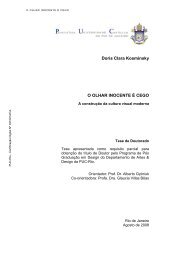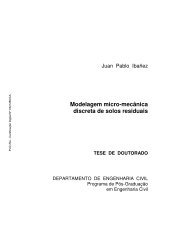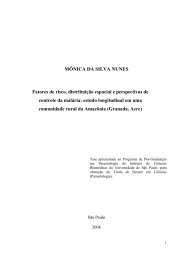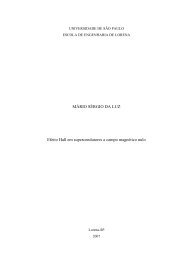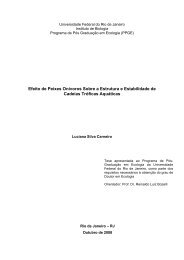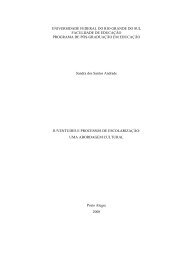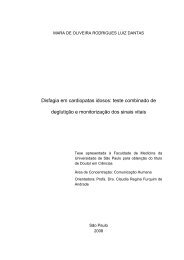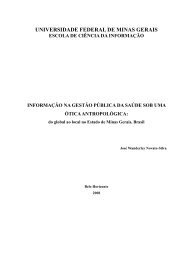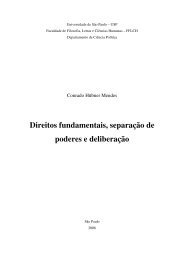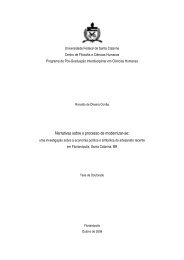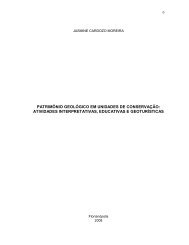- Page 1 and 2:
Universidade de São PauloFaculdade
- Page 3 and 4:
Macedo, ClaudiaO papel modulador do
- Page 5 and 6:
Dedico Especialmente este TrabalhoM
- Page 7 and 8:
AgradecimentosAgradeço do fundo do
- Page 9 and 10:
ÍndiceRESUMO .....................
- Page 11 and 12:
INDICE DE FIGURASFigura 1. Desenvol
- Page 15 and 16:
Promiscuous gene expression in medu
- Page 17 and 18:
INTRODUÇÃO1. INTRODUÇÃO1.1. A m
- Page 19 and 20:
INTRODUÇÃORecentemente surgiram e
- Page 21:
INTRODUÇÃOmigram para a região s
- Page 24 and 25:
INTRODUÇÃOCD4 + CD8 + , e Ccl21 (
- Page 26 and 27:
INTRODUÇÃOos timócitos duplo-pos
- Page 28 and 29:
INTRODUÇÃOgrande diversidade nas
- Page 30 and 31:
INTRODUÇÃOAs células mTECs são
- Page 32 and 33:
INTRODUÇÃODerbinski (2004). Os ti
- Page 34 and 35:
INTRODUÇÃOinvertebrados multicelu
- Page 36 and 37:
INTRODUÇÃOCoraçãoLínguaEstôma
- Page 38 and 39:
INTRODUÇÃO1.3. O papel do gene Au
- Page 40 and 41:
INTRODUÇÃOdefinido pela atividade
- Page 42 and 43:
INTRODUÇÃOpara abordarmos nossa p
- Page 44 and 45:
INTRODUÇÃOesses modelos levam em
- Page 46 and 47:
Hipóteses
- Page 48 and 49:
Objetivos
- Page 50 and 51:
Material e Métodos
- Page 52 and 53:
MATERIAL E MÉTODOSFigura 6. Padrã
- Page 54 and 55:
MATERIAL E MÉTODOScom estes RNAs f
- Page 56 and 57:
MATERIAL E MÉTODOSdos complexos de
- Page 58 and 59:
MATERIAL E MÉTODOSAo RNA total rec
- Page 60 and 61:
4.5. PCRs semi-quantitativas para o
- Page 62 and 63:
MATERIAL E MÉTODOSminutos a 4 °C.
- Page 64 and 65:
MATERIAL E MÉTODOS(Merck), soluç
- Page 66 and 67:
MATERIAL E MÉTODOSEnsaios de co-hi
- Page 68 and 69:
MATERIAL E MÉTODOSRNA TotalANELAME
- Page 70 and 71:
MATERIAL E MÉTODOSa) Preparação
- Page 72 and 73:
MATERIAL E MÉTODOScentrifugação
- Page 74 and 75:
MATERIAL E MÉTODOScanais (Cy3 e Cy
- Page 76 and 77:
MATERIAL E MÉTODOSSpotfinderQuanti
- Page 78 and 79:
MATERIAL E MÉTODOSOnde Xp(i) e Xc(
- Page 80 and 81:
MATERIAL E MÉTODOSO programa SAM p
- Page 82 and 83:
MATERIAL E MÉTODOSextrair automati
- Page 84 and 85:
DELINEAMENTO EXPERIMENTAL5. DELINEA
- Page 86 and 87:
RESULTADOS6. RESULTADOS6.1. Inibiç
- Page 88 and 89:
RESULTADOSPCR semiquantitativa gene
- Page 90 and 91:
RESULTADOS6.3. RT-PCRs semi-quantit
- Page 92 and 93:
RESULTADOS11.00%6,50%AdequadaNão A
- Page 94 and 95:
RESULTADOS6.6. Quantificação e no
- Page 96 and 97:
RESULTADOSPara um melhor entendimen
- Page 98 and 99:
RESULTADOSFigura 25. Agrupamento hi
- Page 100 and 101:
RESULTADOSFigura 26. Gráfico ilust
- Page 102 and 103:
RESULTADOS6.8. Influência do silen
- Page 104 and 105:
Discussão
- Page 106 and 107:
DISCUSSÃOA tolerância do repertó
- Page 108 and 109:
DISCUSSÃOCom relação à técnica
- Page 110 and 111:
DISCUSSÃOgene AIRE (do inglês aut
- Page 112 and 113:
DISCUSSÃOdesse modo a tolerância
- Page 114 and 115:
DISCUSSÃOPML (leucemia promielocit
- Page 116 and 117:
DISCUSSÃOBoehm et al. (2003) afirm
- Page 118 and 119:
DISCUSSÃOprograma Genenetwork (Wu
- Page 120 and 121:
Conclusões
- Page 122 and 123:
Referências Bibliográficas
- Page 124 and 125:
REFERÊNCIAS BIBLIOGRÁFICASBarthlo
- Page 126 and 127:
REFERÊNCIAS BIBLIOGRÁFICASDissert
- Page 128 and 129:
REFERÊNCIAS BIBLIOGRÁFICASGotter
- Page 130 and 131:
REFERÊNCIAS BIBLIOGRÁFICASMatsumo
- Page 132 and 133:
REFERÊNCIAS BIBLIOGRÁFICASby mito
- Page 134 and 135:
REFERÊNCIAS BIBLIOGRÁFICASRossi S
- Page 136 and 137:
REFERÊNCIAS BIBLIOGRÁFICASof thym
- Page 138 and 139:
Anexo I123
- Page 140 and 141:
ANEXO IEST IMAGE:582370 Expressed s
- Page 142 and 143:
ANEXO IDhps IMAGE:583332 Deoxyhypus
- Page 144 and 145:
ANEXO IMapkapk2 IMAGE:572979 MAP ki
- Page 146 and 147:
ANEXO IGm608 IMAGE:583350 Gene mode
- Page 148 and 149:
ANEXO ICcdc72 IMAGE:640628 Coiled-c
- Page 150 and 151:
ANEXO ITranscribed locusTranscribed
- Page 152 and 153:
ANEXO IEST IMAGE:583221 Expressed s
- Page 154 and 155:
ANEXO ITranscribed locusTranscribed
- Page 156 and 157:
ANEXO Irepair deficiency, complemen
- Page 158 and 159:
ANEXO Imember 1EST IMAGE:583824 Exp
- Page 160 and 161:
ANEXO ITranscribed locus IMAGE:5830
- Page 162 and 163:
ANEXO ITfdp1 IMAGE:640119 Transcrib
- Page 164 and 165:
ANEXO IEST IMAGE:583902 Expressed s
- Page 166 and 167:
ANEXO I2410022M11Rik IMAGE:640727 R
- Page 168 and 169:
ANEXO Icontaining 1Kif14 IMAGE:5836
- Page 170 and 171:
ANEXO Imember 3In multiple clusters
- Page 172 and 173:
ANEXO IEST IMAGE:639632 Expressed s
- Page 174 and 175:
ANEXO IAnkrd10 IMAGE:583740 Ankyrin
- Page 176 and 177:
ANEXO IEST IMAGE:641035 Expressed s
- Page 178 and 179:
ANEXO IVcam1 IMAGE:576563 Vascular
- Page 180 and 181:
ANEXO ITegt IMAGE:639877 Testis enh
- Page 182 and 183:
ANEXO I3Ehmt2Euchromatic histone ly
- Page 184 and 185:
ANEXO IEST IMAGE:583217 Expressed s
- Page 186 and 187:
ANEXO IEST IMAGE:640851 Expressed s
- Page 188 and 189:
ANEXO I20 homolog (yeast)Ube1c IMAG
- Page 190 and 191:
ANEXO IRasa3 IMAGE:582174 RAS p21 p
- Page 192 and 193:
ANEXO IEST IMAGE:640642 Expressed s
- Page 194 and 195:
ANEXO I4930566A11Rik IMAGE:583433 R
- Page 196 and 197:
ANEXO IEST IMAGE:640824 Expressed s
- Page 198 and 199:
ANEXO IEST IMAGE:582998 Expressed s
- Page 200 and 201:
Anexo II
- Page 202 and 203:
ANEXO II1500002B03RikIMAGE:1330385
- Page 204 and 205:
ANEXO IIEST IMAGE:640173 Expressed
- Page 206 and 207:
ANEXO IICnot10 IMAGE:576406 CCR4-NO
- Page 208 and 209:
ANEXO IIEST IMAGE:576142 Expressed
- Page 210 and 211:
Anexo III
- Page 212 and 213:
ANEXO III197Ifit1RelaIMAGE:575632Gr
- Page 214 and 215:
ANEXO III199Nde1Nol5aIMAGE:640341Rp
- Page 216 and 217: Manuscrito da Tese
- Page 218 and 219: MANUSCRITOAbstractThe expression of
- Page 220 and 221: MANUSCRITOdominated the scenario in
- Page 222 and 223: MANUSCRITOserum autoantibodies, all
- Page 224 and 225: MANUSCRITOwere transfected with 10
- Page 226 and 227: MANUSCRITOwere analyzed using the M
- Page 228 and 229: MANUSCRITOpurified from ex vivo mou
- Page 230 and 231: MANUSCRITOinformation theory as ARA
- Page 232 and 233: MANUSCRITOKyewski B, Derbinski J, G
- Page 234 and 235: MANUSCRITOBruno R, Sabater L, Tolos
- Page 236 and 237: MANUSCRITOFigure 3. The gene expres
- Page 238 and 239: MANUSCRITOABFigure 5. Genetics netw
- Page 240 and 241: SÚMULACURRICULUM VITAE (Janeiro 20
- Page 242 and 243: ESTÁGIO NO EXTERIORSÚMULA• Labo
- Page 244 and 245: SÚMULAtranscript finishing initiat
- Page 246 and 247: SÚMULAlinhagens isogênicas de cam
- Page 248 and 249: SÚMULABOLSAS DE ESTUDO• Bolsa de
- Page 250 and 251: T cell signaling gene networks duri
- Page 252 and 253: IntroductionThe thymus is an import
- Page 254 and 255: ontogeny using such technology has
- Page 256 and 257: laboratory using a Generation III A
- Page 258 and 259: cDNA microarray data analysisStatis
- Page 260 and 261: Gene networksAs previously mentione
- Page 262 and 263: cells, including human herpesvirus-
- Page 264 and 265: gene was mostly indirectly positive
- Page 268 and 269: 4) Finally, Prrg2 was also identifi
- Page 270 and 271: 14. Kishimoto H, Sprent J (2000) Th
- Page 272 and 273: proliferation of a rat astrocyte ce
- Page 274 and 275: IMMUNOLOGYORIGINAL ARTICLEOnset of
- Page 276 and 277: Promiscuous gene expression in muri
- Page 278 and 279: Promiscuous gene expression in muri
- Page 280 and 281: Promiscuous gene expression in muri
- Page 282 and 283: R.S. Cardoso et al. / Molecular Imm
- Page 284 and 285: R.S. Cardoso et al. / Molecular Imm
- Page 286 and 287: R.S. Cardoso et al. / Molecular Imm
- Page 288 and 289: R.S. Cardoso et al. / Molecular Imm
- Page 290 and 291: Molecular Immunology 42 (2005) 1043
- Page 292 and 293: D.A.R. Magalhães et al. / Molecula
- Page 294 and 295: D.A.R. Magalhães et al. / Molecula
- Page 296 and 297: Molecular and Cellular Biochemistry
- Page 298 and 299: 225Table 1. Target cDNA sequences a
- Page 300 and 301: 227coincided (CBA/J) with expressio



